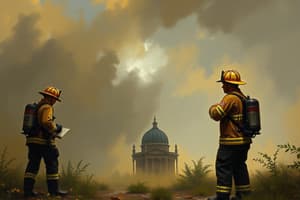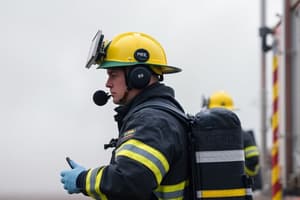Podcast
Questions and Answers
What is the recommended air capacity reserve for firefighters before the SCBA low air alarm sounds?
What is the recommended air capacity reserve for firefighters before the SCBA low air alarm sounds?
- 50%
- 25%
- 75%
- 33% (correct)
Who is primarily responsible for managing air supply for their entire crew?
Who is primarily responsible for managing air supply for their entire crew?
- Individual firefighters
- Company officers (correct)
- Training officers
- Incident commanders
What does the term 'round trip ticket' refer to in air management?
What does the term 'round trip ticket' refer to in air management?
- The distance covered during firefighting activities
- The expectation of air level monitoring throughout an operation (correct)
- The total air supply carried by a firefighter
- The process of refilling SCBA cylinders
Which of the following is NOT a trigger used by captains to assess their crew’s air supply?
Which of the following is NOT a trigger used by captains to assess their crew’s air supply?
What should a firefighter do before entering the hazard zone regarding their SCBA?
What should a firefighter do before entering the hazard zone regarding their SCBA?
What is a critical skill that must be learned in conjunction with air management?
What is a critical skill that must be learned in conjunction with air management?
How many rescuers on average are needed to rescue one firefighter in a MAYDAY situation?
How many rescuers on average are needed to rescue one firefighter in a MAYDAY situation?
Which factor is critical for effective air management during firefighting operations?
Which factor is critical for effective air management during firefighting operations?
What is the primary requirement for a firefighter to be 'MAYDAY' ready?
What is the primary requirement for a firefighter to be 'MAYDAY' ready?
What is crucial to preventing 'MAYDAY' situations for firefighters?
What is crucial to preventing 'MAYDAY' situations for firefighters?
What defines how a fire crew is expected to exit their area of operation?
What defines how a fire crew is expected to exit their area of operation?
How far is it recommended that a fire crew should enter a building without additional support mechanisms?
How far is it recommended that a fire crew should enter a building without additional support mechanisms?
What should be included in an exit plan when operating inside a structure?
What should be included in an exit plan when operating inside a structure?
What common misconception may lead to challenges in executing an exit plan?
What common misconception may lead to challenges in executing an exit plan?
Which aspect of firefighting requires consistent training to maintain proficiency?
Which aspect of firefighting requires consistent training to maintain proficiency?
What should not be included as part of the exit plan for fire crews?
What should not be included as part of the exit plan for fire crews?
Study Notes
Task Level Air Management
- Individual firefighter air management is fundamental to air management policies in firefighting.
- Leaving the hazard zone before SCBA low air alarm activates reserves 33% of air capacity for emergencies.
- Firefighting operations must follow the standard of maintaining awareness of air supply at all times.
- Firefighters are responsible for thorough SCBA checks before shifts, post-use, and when issues arise.
- Understanding air levels before entering, during, and leaving the hazard zone is termed a "round trip ticket."
- Monitoring air supply is essential and should be reinforced by company officers during training.
- Command and sector officers should ensure continuity of operations while crews refill SCBA.
- Accountability for air management extends from individual firefighters to company officers.
- Captains must actively inquire about air levels within their crews and use situational triggers.
- Common triggers include tactical benchmarks, elapsed time notifications, and SCBA low air alarms.
- Effective communication of air levels is crucial to prevent low air emergencies, which pose extreme risks.
- Training indicates that it takes 12 rescuers to retrieve one firefighter in a "MAYDAY" situation.
- Data shows that one in five rescuers will require assistance, leading to a cycle of danger.
- Immediate "Mayday" calls are vital if firefighters believe they are in danger or if others are at risk.
- Firefighters must practice donning and manipulating PASS devices and SCBA emergency bypasses effectively.
- Crews must have an established "exit plan" communicated clearly by the Captain.
- Individual firefighters need to be aware of and understand how to execute the exit plan.
- The exit plan involves using the hose line for egress and knowledge of alternate exits.
- Air consumption must be accounted for when planning entrance and exits, especially in larger buildings.
- Testing indicates a maximum safe entry distance of 150 feet into a building without additional support.
- Air management policy remains consistent across residential and commercial incidents as per Regional Operations Consistency Committee (ROCC).
- All fire department personnel must manage air supplies uniformly regardless of incident type.
Studying That Suits You
Use AI to generate personalized quizzes and flashcards to suit your learning preferences.
Description
This quiz focuses on the importance of individual firefighter air management in incident command systems. It highlights the policy of exiting the hazard zone before the SCBA low air alarm activates, ensuring a safety reserve of air. Understanding this policy is crucial for effective firefighting operations.




